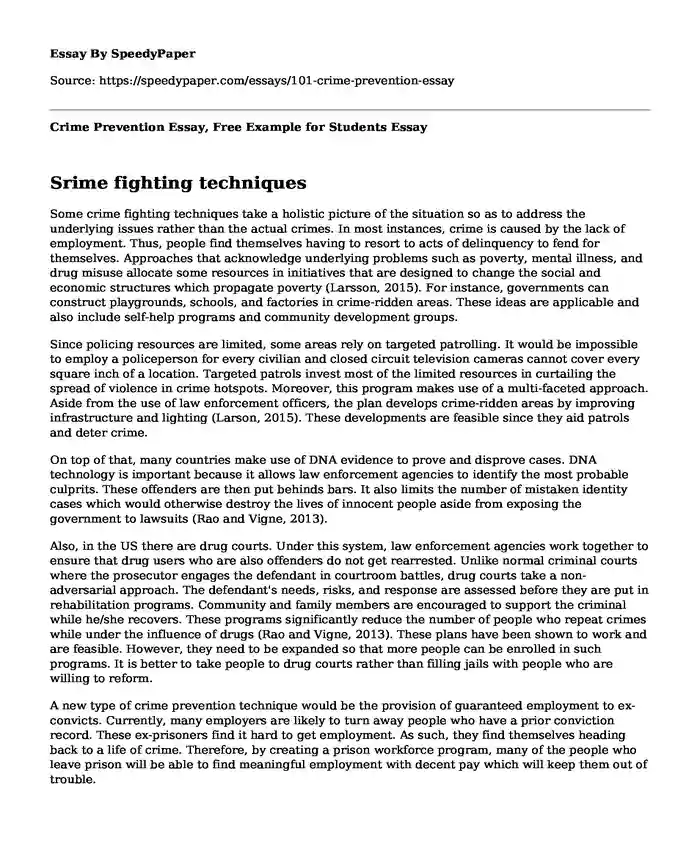
| Type of paper: | Essay |
| Categories: | Criminal law |
| Pages: | 3 |
| Wordcount: | 601 words |
Srime fighting techniques
Some crime fighting techniques take a holistic picture of the situation so as to address the underlying issues rather than the actual crimes. In most instances, crime is caused by the lack of employment. Thus, people find themselves having to resort to acts of delinquency to fend for themselves. Approaches that acknowledge underlying problems such as poverty, mental illness, and drug misuse allocate some resources in initiatives that are designed to change the social and economic structures which propagate poverty (Larsson, 2015). For instance, governments can construct playgrounds, schools, and factories in crime-ridden areas. These ideas are applicable and also include self-help programs and community development groups.
Since policing resources are limited, some areas rely on targeted patrolling. It would be impossible to employ a policeperson for every civilian and closed circuit television cameras cannot cover every square inch of a location. Targeted patrols invest most of the limited resources in curtailing the spread of violence in crime hotspots. Moreover, this program makes use of a multi-faceted approach. Aside from the use of law enforcement officers, the plan develops crime-ridden areas by improving infrastructure and lighting (Larson, 2015). These developments are feasible since they aid patrols and deter crime.
On top of that, many countries make use of DNA evidence to prove and disprove cases. DNA technology is important because it allows law enforcement agencies to identify the most probable culprits. These offenders are then put behinds bars. It also limits the number of mistaken identity cases which would otherwise destroy the lives of innocent people aside from exposing the government to lawsuits (Rao and Vigne, 2013).
Also, in the US there are drug courts. Under this system, law enforcement agencies work together to ensure that drug users who are also offenders do not get rearrested. Unlike normal criminal courts where the prosecutor engages the defendant in courtroom battles, drug courts take a non-adversarial approach. The defendant's needs, risks, and response are assessed before they are put in rehabilitation programs. Community and family members are encouraged to support the criminal while he/she recovers. These programs significantly reduce the number of people who repeat crimes while under the influence of drugs (Rao and Vigne, 2013). These plans have been shown to work and are feasible. However, they need to be expanded so that more people can be enrolled in such programs. It is better to take people to drug courts rather than filling jails with people who are willing to reform.
A new type of crime prevention technique would be the provision of guaranteed employment to ex-convicts. Currently, many employers are likely to turn away people who have a prior conviction record. These ex-prisoners find it hard to get employment. As such, they find themselves heading back to a life of crime. Therefore, by creating a prison workforce program, many of the people who leave prison will be able to find meaningful employment with decent pay which will keep them out of trouble.
Furthermore, to ensure that prisoners gain employment, the correctional department can implement mandatory education programs for inmates. Under such initiatives, inmates will select from the option of classes available such as language, accounting, construction, and technology. These programs impart former criminals with the requisite skills to compete in the job market and permit them to become self-reliant if no jobs are available.
References
Larsson, N. (2015). 24 ways to reduce crime in the world's most violent cities. The Guardian. Retrieved 31 March 2017, from https://www.theguardian.com/global-development-professionals-network/2015/jun/30/24-ways-to-reduce-in-the-worlds-most-violent-cities
Rao, S., and Vigne, N. (2013). Five ways to reduce crime. Urban Institute. Retrieved 31 March 2017, from http://www.urban.org/urban-wire/five-ways-reduce-crime
Cite this page
Crime Prevention Essay, Free Example for Students. (2019, Feb 18). Retrieved from https://speedypaper.net/essays/101-crime-prevention-essay
Request Removal
If you are the original author of this essay and no longer wish to have it published on the SpeedyPaper website, please click below to request its removal:
- Free Essay in American History: Expansion, War and Reconstruction
- Time Stands Still - Meaning of the Play in Our Free Essay
- Free Essay on Why Writing Skills Are Important in Nursing
- Essay Example: Oral Presentation Research Paper
- Essay Example: Women in Leadership and Social Change
- Essay Sample on Social Media Peer Communication and Impacts on Purchase Intentions
- Legal Concepts and Doctrines. Paper Example
Popular categories




